Prefer to read in the language of Molière? 🇫🇷 C'est par ici !
To wrap it up:
- The value proposition canvas helps you define your customer's profile and pair this with your product/service to ensure you're helping users achieve their jobs-to-be-done, solving their pain points and providing them with value
- The Golden Circle framework will allow you to work on your why, what and how
- Starting with the why is how you'll best define a value proposition that matches your audiences needs
Defining your value proposition is by no means easy and yet it is THE essential preliminary step to work through before launching or re-launching a premium strategy.
Quickly, what is a value proposition?
A value proposition is a statement that summarizes why someone should purchase your product or service. It refers to the value that you are providing to your customers should they choose to purchase from you. It’s therefore hugely important and plays a significant role in whether users will partake in any exchanges of value (e.g. subscribe or register to your site).
Given this, how can you even begin to sell a product or service without first defining what it is that you’re selling and how you’re providing value to your customers?
In this article, we’ll work through Poool’s method of defining a value proposition, ensuring that you can write conversion texts, build offer pages and create promotional campaigns with ease.
At Poool, we break this down into 2 steps:
- Define the content and benefits of your offer
- Work on your why, how and what.
- Define the content and benefits of your offer(s)
We propose to work from a framework initially developed by Dr. Alexander Osterwalder, The Value Proposition Canvas, built for ensuring that a product is adapted to its market.
The canvas is divided into two sections: customer profile and value proposition.

Customer profile: Always start with the customer as they’re at the center of your value as a business.
You are also likely to have different customer segments, each with their own needs, wants and interests, so it’s important to complete a unique customer profile for every segment.
- Gains: the benefits that customers expect and need from you. These should appeal to their interests and make them more likely to embrace your value proposition
- Job-to-be-done: this refers to the operational, social and emotional tasks that a client must carry out. It involves any problems they have to solve and what they hope to satisfy
“What social, emotional, and functional jobs does your customer do on a daily basis? They have some functional job that you know probably about. But you’ll also need to uncover how they do that job, how they feel, and what social qualities come into play. For instance, a parent with the job of driving a child to school may also have functional jobs of getting them there on time, ensuring they’re fed throughout the day, making sure they’re not looking like an outcast (social standing may be important), providing the feeling of being loved and appreciated, etc. Ask enough “whys” and you’ll get this info.” - BMI
- Pains: these are the difficulties and negative experiences faced by the customer when trying to get the job done
Value proposition: here we turn to your product or service and how it fits with the above.
- Gain creators: how does the product or service meet the customer’s needs and how does it provide them with value?
- Pain reliever: how does the product or service solve the pain and difficulties that a customer may encounter whilst carrying out this task?
- Product or service: what is the product or service that creates value, solves problems and justifies the creation of value for the customer?
Once these are defined, the question comes down to how this tool can be applied to content producers. We propose …
2. Work on your why, what and how.
For this second section, we’re going to work from The Golden Circle framework laid out by Simon Sinek.
If you’re unfamiliar with his work, we’d recommend having a watch of this video. Although it was posted in 2009, the concepts are still relevant and useful today given that so few businesses are aware of how to define their why, what and how.
The circle is divided into 3 parts: what, how and why.
- What: What do you do? This should be very (very) easy to answer. For a magazine, for example, you publish articles, columns, surveys, etc in paper versions and digitally
- How: How do you do this? With what people, tools, focus, quality, layout, etc. This, again, should be straightforward to answer and, above all, strictly defined within your team
- Why: Why do you do this? A bit trickier and unfortunately not simply as a way to make money. Monetization is the result rather than the why. Instead, here is where you define what you’re going to tell your prospects so that they pay in exchange for your products or services
After the ‘why’, you should consider the following questions:
- Why does this structure exist?
- Why do you get up in the morning?
- Why should people be interested in what you do?
- Why are you useful?
- What makes you different from others in the industry?
- What do you bring to your reader to make them spend time with you?
Most businesses start by answering the obvious questions (on the outside of the circle) and then work their way in towards the center. This leads to simple messaging such as
Subscribe to access all our articles!
But, of course, you can do better.
This is why more successful companies go the other way around, starting from the center (the why) and moving outwards.
Let’s look at some examples of successful promotional campaigns where they have clearly started with the why.
Interested in some personalized advice to kick start your subscription strategy with a strong value proposition? Book a meeting with the team and we’ll see how Poool can help you out!


